Melbourne
Melbourne (/ˈmɛlbərn/ (![]()
| Melbourne Victoria | |||||||||
|---|---|---|---|---|---|---|---|---|---|
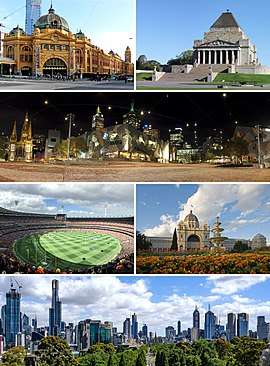 From top, left to right: Flinders Street Station, Shrine of Remembrance, Federation Square, Melbourne Cricket Ground, Royal Exhibition Building, the Melbourne skyline. | |||||||||
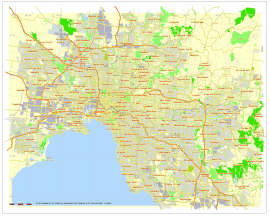 Map of Melbourne, Australia, printable and editable | |||||||||
 Melbourne | |||||||||
| Coordinates | 37°48′49″S 144°57′47″E | ||||||||
| Population | 5,078,193 (2019)[1] (2nd) | ||||||||
| • Density | 508.175/km2 (1,316.17/sq mi) | ||||||||
| Established | 30 August 1835 | ||||||||
| Elevation | 31 m (102 ft) | ||||||||
| Area | 9,993 km2 (3,858.3 sq mi)(GCCSA)[2] | ||||||||
| Time zone | AEST (UTC+10) | ||||||||
| • Summer (DST) | AEDT (UTC+11) | ||||||||
| Location | |||||||||
| LGA(s) | 31 Municipalities across Greater Melbourne | ||||||||
| County | Grant, Bourke, Mornington | ||||||||
| State electorate(s) | 55 electoral districts and regions | ||||||||
| Federal Division(s) | 23 Divisions | ||||||||
| |||||||||
Home to Indigenous Australians for over 40,000 years, the Melbourne area served as a popular meeting place for local Kulin nation clans. A short-lived penal settlement was established at Port Phillip, then part of the British colony of New South Wales, in 1803, but it was not until 1835, with the arrival of free settlers from Van Diemen’s Land (modern-day Tasmania), that Melbourne was founded.[14] It was incorporated as a Crown settlement in 1837, and named Melbourne by the Governor, Richard Bourke on 10 April 1837[15] in honour of the then British Prime Minister, William Lamb, 2nd Viscount Melbourne.[14] In 1851, four years after Queen Victoria declared it a city, Melbourne became the capital of the new colony of Victoria.[16] In the wake of the 1850s Victorian gold rush, the city entered a lengthy boom period that, by the late 1880s, had transformed it into one of the world's largest and wealthiest metropolises.[17][18] After the federation of Australia in 1901, it served as the interim seat of government of the new nation until Canberra became the permanent capital in 1927.[19] Today, it is a leading financial centre in the Asia-Pacific region and ranks 15th in the Global Financial Centres Index.[20]
Melbourne is home to many of Australia's best-known landmarks, such as the Melbourne Cricket Ground, the National Gallery of Victoria and the World Heritage-listed Royal Exhibition Building. Noted for its cultural heritage, the city gave rise to Australian rules football, Australian impressionism and Australian cinema, and has more recently been recognised as a UNESCO City of Literature and a global centre for street art, live music and theatre. It hosts major annual international events, such as the Australian Grand Prix and the Australian Open, and also hosted the 1956 Summer Olympics and the 2006 Commonwealth Games. Melbourne consistently ranked as the world's most liveable city for much of the 2010s.[21]
Melbourne Airport, also known as Tullamarine Airport, is the second busiest airport in Australia, and the city's port is the nation's busiest seaport.[22] Its main metropolitan rail terminus is Flinders Street station and its main regional rail and road coach terminus is Southern Cross station. It also has Australia's most extensive freeway network and the largest urban tram network in the world.[23]
History
Early history and foundation
Indigenous Australians have lived in the Melbourne area for at least 40,000 years.[24] When European settlers arrived in the 19th century, at least 20,000 Kulin people from three distinct language groups — the Wurundjeri, Boonwurrung and Wathaurong — resided in the area.[25][26] It was an important meeting place for the clans of the Kulin nation alliance and a vital source of food and water.[27][28]
The first British settlement in Victoria, then part of the penal colony of New South Wales, was established by Colonel David Collins in October 1803, at Sullivan Bay, near present-day Sorrento. The following year, due to a perceived lack of resources, these settlers relocated to Van Diemen's Land (present-day Tasmania) and founded the city of Hobart. It would be 30 years before another settlement was attempted.[29]
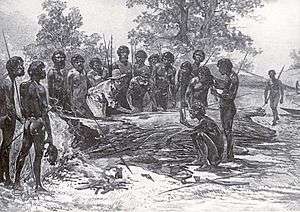
In May and June 1835, John Batman, a leading member of the Port Phillip Association in Van Diemen's Land, explored the Melbourne area, and later claimed to have negotiated a purchase of 600,000 acres (2,400 km2) with eight Wurundjeri elders.[27][28] Batman selected a site on the northern bank of the Yarra River, declaring that "this will be the place for a village" before returning to Van Diemen's Land.[30] In August 1835, another group of Vandemonian settlers arrived in the area and established a settlement at the site of the current Melbourne Immigration Museum. Batman and his group arrived the following month and the two groups ultimately agreed to share the settlement, initially known by the native name of Dootigala.[31][32]
Batman's Treaty with the Aborigines was annulled by Richard Bourke, the Governor of New South Wales (who at the time governed all of eastern mainland Australia), with compensation paid to members of the association.[27] In 1836, Bourke declared the city the administrative capital of the Port Phillip District of New South Wales, and commissioned the first plan for its urban layout, the Hoddle Grid, in 1837.[33] Known briefly as Batmania,[34] the settlement was named Melbourne on 10 April 1837 by Governor Richard Bourke[15] after the British Prime Minister, William Lamb, 2nd Viscount Melbourne, whose seat was Melbourne Hall in the market town of Melbourne, Derbyshire. That year, the settlement's general post office officially opened with that name.[35]
Between 1836 and 1842, Victorian Aboriginal groups were largely dispossessed of their land by European settlers.[36] By January 1844, there were said to be 675 Aborigines resident in squalid camps in Melbourne.[37] The British Colonial Office appointed five Aboriginal Protectors for the Aborigines of Victoria, in 1839, however their work was nullified by a land policy that favoured squatters who took possession of Aboriginal lands.[38] By 1845, fewer than 240 wealthy Europeans held all the pastoral licences then issued in Victoria and became a powerful political and economic force in Victoria for generations to come.[39]
Letters patent of Queen Victoria, issued on 25 June 1847, declared Melbourne a city.[16] On 1 July 1851, the Port Phillip District separated from New South Wales to become the Colony of Victoria, with Melbourne as its capital.[40]
Victorian gold rush
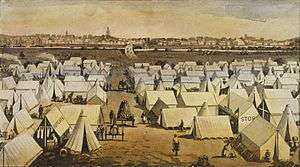
The discovery of gold in Victoria in mid-1851 sparked a gold rush, and Melbourne, the colony's major port, experienced rapid growth. Within months, the city's population had nearly doubled from 25,000 to 40,000 inhabitants.[41] Exponential growth ensued, and by 1865 Melbourne had overtaken Sydney as Australia's most populous city.[42]
An influx of intercolonial and international migrants, particularly from Europe and China, saw the establishment of slums, including Chinatown and a temporary "tent city" on the southern banks of the Yarra. In the aftermath of the 1854 Eureka Rebellion, mass public-support for the plight of the miners resulted in major political changes to the colony, including improvements in working conditions across mining, agriculture, manufacturing and other local industries. At least twenty nationalities took part in the rebellion, giving some indication of immigration flows at the time.[43]
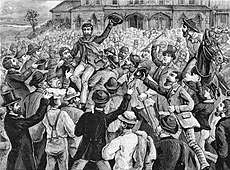
With the wealth brought in from the gold rush and the subsequent need for public buildings, a program of grand civic construction soon began. The 1850s and 1860s saw the commencement of Parliament House, the Treasury Building, the Old Melbourne Gaol, Victoria Barracks, the State Library, University of Melbourne, General Post Office, Customs House, the Melbourne Town Hall, St Patrick's cathedral, though many remained uncompleted for decades, with some still not finished as of 2018.
The layout of the inner suburbs on a largely one-mile grid pattern, cut through by wide radial boulevards and parklands surrounding the central city, was largely established in the 1850s and 1860s. These areas rapidly filled with the ubiquitous terrace houses, as well as with detached houses and grand mansions, while some of the major roads developed as shopping streets. Melbourne quickly became a major finance centre, home to several banks, the Royal Mint, and (in 1861) Australia's first stock exchange.[44] In 1855, the Melbourne Cricket Club secured possession of its now famous ground, the MCG. Members of the Melbourne Football Club codified Australian football in 1859,[45] and in 1861, the first Melbourne Cup race was held. Melbourne acquired its first public monument, the Burke and Wills statue, in 1864.
With the gold rush largely over by 1860, Melbourne continued to grow on the back of continuing gold-mining, as the major port for exporting the agricultural products of Victoria (especially wool) and with a developing manufacturing sector protected by high tariffs. An extensive radial railway network spread into the countryside from the late 1850s. Construction started on further major public buildings in the 1860s and 1870s, such as the Supreme Court, Government House, and the Queen Victoria Market. The central city filled up with shops and offices, workshops, and warehouses. Large banks and hotels faced the main streets, with fine townhouses in the east end of Collins Street, contrasting with tiny cottages down laneways within the blocks. The Aboriginal population continued to decline, with an estimated 80% total decrease by 1863, due primarily to introduced diseases (particularly smallpox[25]), frontier violence and dispossession of their lands.
Land boom and bust
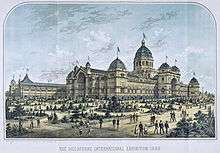
The decade of the 1880s saw extraordinary growth: consumer confidence, easy access to credit, and steep increases in land prices led to an enormous amount of construction. During this "land boom", Melbourne reputedly became the richest city in the world,[17] and the second-largest (after London) in the British Empire.[46]
The decade began with the Melbourne International Exhibition in 1880, held in the large purpose-built Exhibition Building. In 1880 a telephone exchange was established, and in the same year the foundations of St Paul's, were laid; in 1881 electric light was installed in the Eastern Market, and in the following year a generating station capable of supplying 2,000 incandescent lamps was in operation.[47] In 1885 the Melbourne Tramway Trust built the first line of the Melbourne cable tramway system, which became one of the world's most extensive systems by 1890.
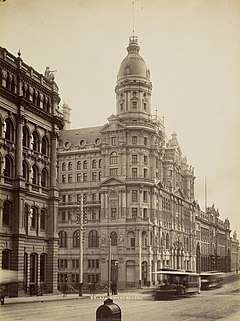
In 1885 visiting English journalist George Augustus Henry Sala coined the phrase "Marvellous Melbourne", which stuck long into the twentieth century and which Melburnians still use today.[48] Melbourne's land-boom reached a peak in 1888, fuelled by consumer confidence and escalating land-value.[49] As a result of the boom, large commercial buildings, grand edifices, banks, coffee palaces, terrace housing and palatial mansions proliferated in the city.[49] The establishment of a hydraulic facility in 1887 allowed for the local manufacture of elevators, resulting in the first construction of high-rise buildings;[50] most notably the APA Building, amongst the world's tallest commercial buildings upon completion in 1889.[49] This period also saw the expansion of a major radial rail-based transport network.[51]
In 1888 the Exhibition Building hosted a second event, even larger than the first: the Melbourne Centennial Exhibition. This spurred the construction of numerous hotels, including the 500-room Federal Hotel, The Palace Hotel in Bourke Street (both since demolished), and the doubling in size of the Grand (Windsor).
A brash boosterism that had typified Melbourne during this time ended in the early 1890s with a severe economic depression, sending the local finance- and property-industries into a period of chaos,[49][52] during which 16 small "land banks" and building societies collapsed, and 133 limited companies went into liquidation. The Melbourne financial crisis was a contributing factor in the Australian economic depression of the 1890s and in the Australian banking crisis of 1893. The effects of the depression on the city were profound, with virtually no new construction until the late 1890s.[53][54]
De facto Capital of Australia
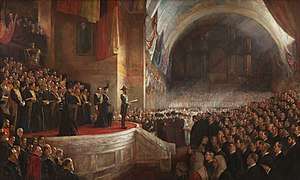
At the time of Australia's federation on 1 January 1901, Melbourne became the seat of government of the federation. The first federal parliament was convened on 9 May 1901 in the Royal Exhibition Building, subsequently moving to the Victorian Parliament House where it was located until 1927, when it was moved to Canberra. The Governor-General of Australia resided at Government House in Melbourne until 1930 and many major national institutions remained in Melbourne well into the twentieth century.[55]
Post-war period
In the immediate years after World War II, Melbourne expanded rapidly, its growth boosted by post-war immigration to Australia, primarily from Southern Europe and the Mediterranean.[56] While the "Paris End" of Collins Street began Melbourne's boutique shopping and open air cafe cultures,[57] the city centre was seen by many as stale—the dreary domain of office workers—something expressed by John Brack in his famous painting Collins St., 5 pm (1955).[58] Up until the 21st century, Melbourne was considered Australia's "industrial heartland".[59]
Height limits in the CBD were lifted in 1958, after the construction of ICI House, transforming the city's skyline with the introduction of skyscrapers. Suburban expansion then intensified, served by new indoor malls beginning with Chadstone Shopping Centre.[60] The post-war period also saw a major renewal of the CBD and St Kilda Road which significantly modernised the city.[61] New fire regulations and redevelopment saw most of the taller pre-war CBD buildings either demolished or partially retained through a policy of facadism. Many of the larger suburban mansions from the boom era were also either demolished or subdivided.
To counter the trend towards low-density suburban residential growth, the government began a series of controversial public housing projects in the inner city by the Housing Commission of Victoria, which resulted in demolition of many neighbourhoods and a proliferation of high-rise towers.[62] In later years, with the rapid rise of motor vehicle ownership, the investment in freeway and highway developments greatly accelerated the outward suburban sprawl and declining inner city population. The Bolte government sought to rapidly accelerate the modernisation of Melbourne. Major road projects including the remodelling of St Kilda Junction, the widening of Hoddle Street and then the extensive 1969 Melbourne Transportation Plan changed the face of the city into a car-dominated environment.[63]
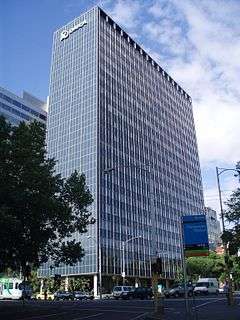
Australia's financial and mining booms during 1969 and 1970 resulted in establishment of the headquarters of many major companies (BHP Billiton and Rio Tinto, among others) in the city. Nauru's then booming economy resulted in several ambitious investments in Melbourne, such as Nauru House.[64] Melbourne remained Australia's main business and financial centre until the late 1970s, when it began to lose this primacy to Sydney.[65]
Melbourne experienced an economic downturn between 1989 and 1992, following the collapse of several local financial institutions. In 1992, the newly elected Kennett government began a campaign to revive the economy with an aggressive development campaign of public works coupled with the promotion of the city as a tourist destination with a focus on major events and sports tourism.[66] During this period the Australian Grand Prix moved to Melbourne from Adelaide. Major projects included the construction of a new facility for the Melbourne Museum, Federation Square, the Melbourne Exhibition and Convention Centre, Crown Casino and the CityLink tollway. Other strategies included the privatisation of some of Melbourne's services, including power and public transport, and a reduction in funding to public services such as health, education and public transport infrastructure.[67]
Contemporary Melbourne
Since the mid-1990s, Melbourne has maintained significant population and employment growth. There has been substantial international investment in the city's industries and property market. Major inner-city urban renewal has occurred in areas such as Southbank, Port Melbourne, Melbourne Docklands and more recently, South Wharf. Melbourne sustained the highest population increase and economic growth rate of any Australian capital city from 2001 to 2004.[68]
From 2006, the growth of the city extended into "green wedges" and beyond the city's urban growth boundary. Predictions of the city's population reaching 5 million people pushed the state government to review the growth boundary in 2008 as part of its Melbourne @ Five Million strategy.[69] In 2009, Melbourne was less affected by the late-2000s financial crisis in comparison to other Australian cities. At this time, more new jobs were created in Melbourne than any other Australian city—almost as many as the next two fastest growing cities, Brisbane and Perth, combined,[70] and Melbourne's property market remained highly priced,[71] resulting in historically high property prices and widespread rent increases.[72] In 2018, Melbourne was classified as an Alpha city by the Globalization and World Cities Research Network.[73]
Geography

Melbourne is in the southeastern part of mainland Australia, within the state of Victoria. Geologically, it is built on the confluence of Quaternary lava flows to the west, Silurian mudstones to the east, and Holocene sand accumulation to the southeast along Port Phillip. The southeastern suburbs are situated on the Selwyn fault which transects Mount Martha and Cranbourne.
Melbourne extends along the Yarra River towards the Yarra Valley and the Dandenong Ranges to the east. It extends northward through the undulating bushland valleys of the Yarra's tributaries—Moonee Ponds Creek (toward Tullamarine Airport), Merri Creek, Darebin Creek and Plenty River—to the outer suburban growth corridors of Craigieburn and Whittlesea.
The city reaches southeast through Dandenong to the growth corridor of Pakenham towards West Gippsland, and southward through the Dandenong Creek valley and the city of Frankston. In the west, it extends along the Maribyrnong River and its tributaries north towards Sunbury and the foothills of the Macedon Ranges, and along the flat volcanic plain country towards Melton in the west, Werribee at the foothills of the You Yangs granite ridge south west of the CBD. The Little River, and the township of the same name, marks the border between Melbourne and neighbouring Geelong city.
Melbourne's major bayside beaches are in the various suburbs along the shores of Port Phillip Bay, in areas like Port Melbourne, Albert Park, St Kilda, Elwood, Brighton, Sandringham, Mentone, Frankston, Altona, Williamstown and Werribee South. The nearest surf beaches are 85 kilometres (53 mi) south of the Melbourne CBD in the back-beaches of Rye, Sorrento and Portsea.[74][75]
Climate
.jpg)
Melbourne has a temperate oceanic climate (Köppen climate classification Cfb) with warm to hot summers and mild winters.[76][77] Melbourne is well known for its changeable weather conditions, mainly due to it being located on the boundary of hot inland areas and the cool southern ocean. This temperature differential is most pronounced in the spring and summer months and can cause strong cold fronts to form. These cold fronts can be responsible for varied forms of severe weather from gales to thunderstorms and hail, large temperature drops and heavy rain. Winters, however, are usually very stable, but rather damp and often cloudy.
Port Phillip is often warmer than the surrounding oceans and/or the land mass, particularly in spring and autumn; this can set up a "bay effect" similar to the "lake effect" seen in colder climates where showers are intensified leeward of the bay. Relatively narrow streams of heavy showers can often affect the same places (usually the eastern suburbs) for an extended period, while the rest of Melbourne and surrounds stays dry. Overall, Melbourne is, owing to the rain shadow of the Otway Ranges, nonetheless drier than average for southern Victoria. Within the city and surrounds, rainfall varies widely, from around 425 millimetres (17 in) at Little River to 1,250 millimetres (49 in) on the eastern fringe at Gembrook. Melbourne receives 48.6 clear days annually. Dewpoint temperatures in the summer range from 9.5 to 11.7 °C (49.1 to 53.1 °F).[78]
Melbourne is also prone to isolated convective showers forming when a cold pool crosses the state, especially if there is considerable daytime heating. These showers are often heavy and can include hail, squalls, and significant drops in temperature, but they often pass through very quickly with a rapid clearing trend to sunny and relatively calm weather and the temperature rising back to what it was before the shower. This can occur in the space of minutes and can be repeated many times a day, giving Melbourne a reputation for having "four seasons in one day",[79] a phrase that is part of local popular culture.[80] The lowest temperature on record is −2.8 °C (27.0 °F), on 21 July 1869.[81] The highest temperature recorded in Melbourne city was 46.4 °C (115.5 °F), on 7 February 2009.[82] While snow is occasionally seen at higher elevations in the outskirts of the city, it has not been recorded in the Central Business District since 1986.[83]
The average temperature of the sea ranges from 14.6 °C (58.3 °F) in September to 18.8 °C (65.8 °F) in February;[84] at Port Melbourne, the average sea temperature range is the same.[85]
| Climate data for Melbourne Regional Office (1991–2020) | |||||||||||||
|---|---|---|---|---|---|---|---|---|---|---|---|---|---|
| Month | Jan | Feb | Mar | Apr | May | Jun | Jul | Aug | Sep | Oct | Nov | Dec | Year |
| Record high °C (°F) | 45.6 (114.1) |
46.4 (115.5) |
41.7 (107.1) |
34.9 (94.8) |
28.7 (83.7) |
22.4 (72.3) |
23.3 (73.9) |
26.5 (79.7) |
31.4 (88.5) |
36.9 (98.4) |
40.9 (105.6) |
43.7 (110.7) |
46.4 (115.5) |
| Mean maximum °C (°F) | 39.2 (102.6) |
37.9 (100.2) |
34.7 (94.5) |
29.0 (84.2) |
22.8 (73.0) |
18.2 (64.8) |
17.6 (63.7) |
20.5 (68.9) |
24.8 (76.6) |
29.5 (85.1) |
34.0 (93.2) |
36.9 (98.4) |
40.5 (104.9) |
| Average high °C (°F) | 27.0 (80.6) |
26.9 (80.4) |
24.6 (76.3) |
21.1 (70.0) |
17.6 (63.7) |
15.1 (59.2) |
14.5 (58.1) |
15.9 (60.6) |
18.1 (64.6) |
20.5 (68.9) |
22.9 (73.2) |
24.8 (76.6) |
20.8 (69.4) |
| Daily mean °C (°F) | 21.6 (70.9) |
21.7 (71.1) |
19.6 (67.3) |
16.5 (61.7) |
13.7 (56.7) |
11.7 (53.1) |
11.0 (51.8) |
11.9 (53.4) |
13.8 (56.8) |
15.7 (60.3) |
17.9 (64.2) |
19.6 (67.3) |
16.2 (61.2) |
| Average low °C (°F) | 16.1 (61.0) |
16.4 (61.5) |
14.6 (58.3) |
11.8 (53.2) |
9.8 (49.6) |
8.2 (46.8) |
7.5 (45.5) |
7.9 (46.2) |
9.4 (48.9) |
10.9 (51.6) |
12.8 (55.0) |
14.3 (57.7) |
11.6 (52.9) |
| Mean minimum °C (°F) | 9.5 (49.1) |
9.6 (49.3) |
7.7 (45.9) |
5.3 (41.5) |
3.2 (37.8) |
1.5 (34.7) |
0.9 (33.6) |
1.5 (34.7) |
2.8 (37.0) |
4.2 (39.6) |
6.3 (43.3) |
8.3 (46.9) |
0.2 (32.4) |
| Record low °C (°F) | 5.5 (41.9) |
4.5 (40.1) |
2.8 (37.0) |
1.5 (34.7) |
−1.1 (30.0) |
−2.2 (28.0) |
−2.8 (27.0) |
−2.1 (28.2) |
−0.5 (31.1) |
0.1 (32.2) |
2.5 (36.5) |
4.4 (39.9) |
−2.8 (27.0) |
| Average rainfall mm (inches) | 44.2 (1.74) |
50.2 (1.98) |
39.0 (1.54) |
53.2 (2.09) |
43.9 (1.73) |
49.5 (1.95) |
39.8 (1.57) |
47.0 (1.85) |
54.5 (2.15) |
55.8 (2.20) |
63.3 (2.49) |
60.9 (2.40) |
600.9 (23.66) |
| Average rainy days (≥ 1mm) | 5.6 | 5.0 | 5.5 | 7.1 | 8.1 | 8.6 | 8.3 | 9.4 | 9.8 | 9.0 | 7.7 | 6.5 | 90.6 |
| Average afternoon relative humidity (%) | 47 | 47 | 47 | 50 | 57 | 61 | 59 | 53 | 50 | 47 | 47 | 46 | 51 |
| Mean monthly sunshine hours | 272.8 | 228.8 | 226.3 | 186.0 | 142.6 | 123.0 | 136.4 | 167.4 | 186.0 | 226.3 | 225.0 | 263.5 | 2,384.1 |
| Source: Bureau of Meteorology.[86][87][88] | |||||||||||||
Urban structure

Melbourne's urban area is approximately 2,453 km2, slightly larger than that of London and Mexico City,[89] while its metropolitan area is 9,993 km2 (3,858 sq mi)–larger than Jakarta (at 7,063 km2), but smaller than New York City (at 11,875 km2). The Hoddle Grid, a grid of streets measuring approximately 1 by 1⁄2 kilometre (0.62 by 0.31 mi), forms the nucleus of Melbourne's central business district (CBD). The grid's southern edge fronts onto the Yarra River. More recent office, commercial and public developments in the adjoining districts of Southbank and Docklands have made these areas into extensions of the CBD in all but name. A byproduct of the CBD's layout is its network of lanes and arcades, such as Block Arcade and Royal Arcade.[90][91]
Melbourne's CBD, compared with other Australian cities, has unrestricted height limits. As a result, it has become Australia's most densely populated area with approximately 19,500 residents per square kilometre,[92] and is home to more skyscrapers than any other Australian city, the tallest being Australia 108, situated in Southbank.[93]
The CBD and surrounds also contain many significant historic buildings such as the Royal Exhibition Building, the Melbourne Town Hall and Parliament House.[94][95] Although the area is described as the centre, it is not actually the demographic centre of Melbourne at all, due to an urban sprawl to the south east, the demographic centre being located at Glen Iris.[96] Melbourne is typical of Australian capital cities in that after the turn of the 20th century, it expanded with the underlying notion of a 'quarter acre home and garden' for every family, often referred to locally as the Australian Dream.[97][98] This, coupled with the popularity of the private automobile after 1945, led to the auto-centric urban structure now present today in the middle and outer suburbs. Much of metropolitan Melbourne is accordingly characterised by low density sprawl, whilst its inner city areas feature predominantly medium-density, transit-oriented urban forms. The city centre, Docklands, St. Kilda Road and Southbank areas feature high-density forms.
Melbourne is often referred to as Australia's garden city, and the state of Victoria was once known as the garden state.[99][100][101] There is an abundance of parks and gardens in Melbourne,[102] many close to the CBD with a variety of common and rare plant species amid landscaped vistas, pedestrian pathways and tree-lined avenues. Melbourne's parks are often considered the best public parks in all of Australia's major cities.[103] There are also many parks in the surrounding suburbs of Melbourne, such as in the municipalities of Stonnington, Boroondara and Port Phillip, south east of the central business district. Several national parks have been designated around the urban area of Melbourne, including the Mornington Peninsula National Park, Port Phillip Heads Marine National Park and Point Nepean National Park in the southeast, Organ Pipes National Park to the north and Dandenong Ranges National Park to the east. There are also a number of significant state parks just outside Melbourne.[104][105] The extensive area covered by urban Melbourne is formally divided into hundreds of suburbs (for addressing and postal purposes), and administered as local government areas[106] 31 of which are located within the metropolitan area.[107]
Housing

Melbourne has minimal public housing and high demand for rental housing, which is becoming unaffordable for some.[108][109][110] Public housing is usually provided by the Housing Commission of Victoria, and operates within the framework of the Commonwealth-State Housing Agreement, by which federal and state governments provide housing funding.
Melbourne is experiencing high population growth, generating high demand for housing. This housing boom has increased house prices and rents, as well as the availability of all types of housing. Subdivision regularly occurs in the outer areas of Melbourne, with numerous developers offering house and land packages. However, after the release of Melbourne 2030 in 2002, planning policies have encouraged medium-density and high-density development in existing areas with greater access to public transport and other services, Melbourne's middle and outer-ring suburbs have seen significant brownfields redevelopment.[111]
Architecture

On the back of the 1850s gold rush and 1880s land boom, Melbourne became renowned as one of the world's great Victorian-era cities, a reputation that persists due to its diverse range of Victorian architecture.[112] Outside the CBD, high concentrations of well-preserved Victorian-era buildings can also be found in the inner suburbs, such as Carlton, East Melbourne and South Melbourne.[113] Outstanding examples of Melbourne's built Victorian heritage include the World Heritage-listed Royal Exhibition Building (1880), the General Post Office (1867), Hotel Windsor (1884) and the Block Arcade (1891).[114] Very little remains of Melbourne's pre-gold rush architecture; St James Old Cathedral (1839) and St Francis' Church (1845) are among the few surviving examples in the CBD.
.jpg)
The city also features the Shrine of Remembrance, which was built as a memorial to the men and women of Victoria who served in World War I and is now a memorial to all Australians who have served in war. The now demolished Queen Anne style APA Australian Building (1889), the world's 3rd tallest building at the time of completion,[116] is erroneously said to have anticipated the skyscraper race in New York City and Chicago.[94] It was demolished in 1980 and replaced by a smaller, four-storey structure.[117] A similar fate met other grand pre-war boom-era buildings in the city, notably the elaborate Victorian Federal Coffee Palace (also known as The Federal Hotel), located on Collins Street until its demolition in 1973.[118]
Residential architecture is not defined by a single architectural style, but rather an eclectic mix of large McMansion-style houses (particularly in areas of urban sprawl), apartment buildings, condominiums, and townhouses which generally characterise the medium-density inner-city neighbourhoods. Freestanding dwellings with relatively large gardens are perhaps the most common type of housing outside inner city Melbourne. Victorian terrace housing, townhouses and historic Italianate, Tudor revival and Neo-Georgian mansions are all common in inner-city neighbourhoods such as Carlton, Fitzroy and further into suburban enclaves like Toorak.
Culture
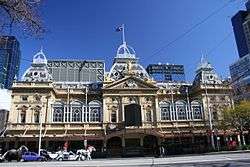
Often referred to as Australia's cultural capital, Melbourne is recognised globally as a centre of sport, music, theatre, comedy, art, literature, film and television.[119] For much of the 2010s, it held the top position in The Economist Intelligence Unit's list of the world's most liveable cities, partly due to its cultural attributes.[21]
The city celebrates a wide variety of annual cultural events and festivals of all types, including the Melbourne International Arts Festival, Melbourne International Comedy Festival, Melbourne Fringe Festival and Moomba, Australia's largest free community festival.
The State Library of Victoria, founded in 1854, is one of the world's oldest free public libraries and, as of 2018, the fourth most-visited library globally.[120] Between the gold rush and the crash of 1890, Melbourne was Australia's literary capital, famously referred to by Henry Kendall as "that wild bleak Bohemia south of the Murray".[121] At this time, Melbourne-based writers and poets Marcus Clarke, Adam Lindsay Gordon and Rolf Boldrewood produced classic visions of colonial life. Fergus Hume's The Mystery of a Hansom Cab (1886), the fastest-selling crime novel of the era, is set in Melbourne, as is Australia's best-selling book of poetry, C. J. Dennis' The Songs of a Sentimental Bloke (1915).[122] Contemporary Melbourne authors who have written award-winning books set in the city include Peter Carey, Helen Garner and Christos Tsiolkas. Melbourne has Australia's widest range of bookstores, as well as the nation's largest publishing sector.[123] The city is also home to the Melbourne Writers Festival and hosts the Victorian Premier's Literary Awards. In 2008, it became the second city to be named a UNESCO City of Literature.
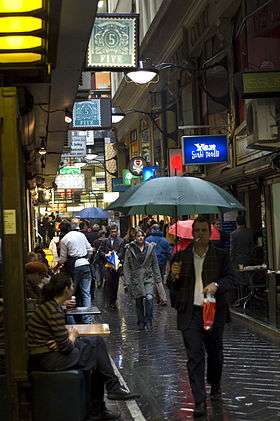
Ray Lawler's play Summer of the Seventeenth Doll is set in Carlton and debuted in 1955, the same year that Edna Everage, Barry Humphries' Moonee Ponds housewife character, first appeared on stage, both sparking international interest in Australian theatre. Melbourne's East End Theatre District is known for its Victorian era theatres, such as the Athenaeum, Her Majesty's and the Princess, as well as the Forum and the Regent. Heritage-listed theatres outside the district include The Capitol and the art deco Palais Theatre, a St Kilda landmark and Australia's largest seated theatre with a capacity of 3,000 people.[124] The Arts Precinct in Southbank is home to Arts Centre Melbourne (which includes the State Theatre and Hamer Hall), as well as the Melbourne Recital Centre and Southbank Theatre, home of the Melbourne Theatre Company, Australia's oldest professional theatre company.[125] The Australian Ballet, Opera Australia and Melbourne Symphony Orchestra are also based in the precinct.
Melbourne has been called "the live music capital of the world";[126] one study found it has more music venues per capita than any other world city sampled, with 17.5 million patron visits to 553 venues in 2016.[126][127] The Sidney Myer Music Bowl in Kings Domain hosted the largest crowd ever for a music concert in Australia when an estimated 200,000 attendees saw Melbourne band The Seekers in 1967.[128] Airing between 1974 and 1987, Melbourne's Countdown helped launch the careers of Crowded House, Men at Work and Kylie Minogue, among other local acts. Several distinct post-punk scenes flourished in Melbourne during the late 1970s, including the Fitzroy-based Little Band scene and the St Kilda scene centered at the Crystal Ballroom, which featured members of Dead Can Dance and Nick Cave and the Bad Seeds, respectively.[129] More recent independent acts from Melbourne to achieve global recognition include The Avalanches, Gotye and King Gizzard and the Lizard Wizard. Melbourne is also regarded as a centre of EDM, and lends its name to the Melbourne Bounce genre and the Melbourne Shuffle dance style, both of which emerged out of the city's underground rave scene.[130]
Established in 1861, the National Gallery of Victoria is Australia's oldest and largest art museum. Several art movements originated in Melbourne, most famously the Heidelberg School of impressonists, named after a suburb where they camped to paint en plein air in the 1880s.[131] During the interwar period, the Australian tonalists emerged,[132] followed by the Angry Penguins, a group of avant-garde painters who stayed at a dairy farm in Bulleen, now the Heide Museum of Modern Art. The city is also home to the Australian Centre for Contemporary Art. Since the early 2000s, Melbourne street art has become internationally renowned and a major drawcard for tourists, with "laneway galleries" such as Hosier Lane attracting more Instagram hashtags than some of the city's traditional attractions, such as the Melbourne Zoo.[133][134]
A quarter century after bushranger Ned Kelly's execution at Old Melbourne Gaol, the Melbourne-produced The Story of the Kelly Gang (1906), the world's first feature-length narrative film, premiered at the above-named Athenaeum, spurring Australia's first cinematic boom.[135] Melbourne remained a world leader in filmmaking until the mid-1910s, when several factors, including a ban on bushranger films, contributed to a decades-long decline of the industry.[135] A notable film shot and set in Melbourne during this lull was On the Beach (1959).[136] Melbourne filmmakers led the Australian Film Revival with ocker comedies such as Stork (1971) and Alvin Purple (1973).[137] Other films shot and set in Melbourne include Mad Max (1979), Romper Stomper (1992), Chopper (2000) and Animal Kingdom (2010). The Melbourne International Film Festival began in 1952 and is one of the world's oldest film festivals. The AACTA Awards, Australia's top screen awards, were inaugurated by the festival in 1958. Melbourne is also home to Docklands Studios Melbourne (the city's largest film and television studio complex),[138] the Australian Centre for the Moving Image and the headquarters of Village Roadshow Pictures, Australia's largest film production company.
Sports
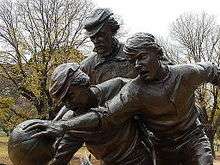
.jpg)
Melbourne has long been regarded as Australia's sporting capital due to the role it has played in the development of Australian sport, the range and quality of its sporting events and venues, and its high rates of spectatorship and participation.[139] The city is also home to 27 professional sports teams competing at the national level, the most of any Australian city. Melbourne's sporting reputation was recognised in 2016 when, after being ranked as the world's top sports city three times biennially, the Ultimate Sports City Awards in Switzerland named it 'Sports City of the Decade'.[140]
The city has hosted a number of major international sporting events, most notably the 1956 Summer Olympic Games, the first Olympic Games held outside Europe and the United States.[141] Melbourne also hosted the 2006 Commonwealth Games, and is home to several major annual international events, including the Australian Open, the first of the four Grand Slam tennis tournaments. First held in 1861 and declared a public holiday for all Melburnians in 1873, the Melbourne Cup is the world's richest handicap horse race, and is known as "the race that stops a nation". The Formula One Australian Grand Prix has been held at the Albert Park Circuit since 1996.
Cricket was one of the first sports to become organised in Melbourne with the Melbourne Cricket Club forming within three years of settlement. The club manages the 100,000 capacity Melbourne Cricket Ground (MCG). Established in 1853, the MCG is notable for hosting the first Test match and the first One Day International, played between Australia and England in 1877 and 1971, respectively. It is also the home of the National Sports Museum,[142] and serves as the home ground of the Victoria cricket team. At Twenty20 level, the Melbourne Stars and Melbourne Renegades compete in the Big Bash League.
Australian rules football, Australia's most popular spectator sport, traces its origins to matches played in parklands next to the MCG in 1858. Its first laws were codified the following year by the Melbourne Football Club,[143] also a founding member, in 1896, of the Australian Football League (AFL), the sport's elite professional competition. Hadquartered at Docklands Stadium, the AFL fields a further eight Melbourne-based clubs: Carlton, Collingwood, Essendon, Hawthorn, North Melbourne, Richmond, St Kilda, and the Western Bulldogs.[144] The city hosts up to five AFL matches per round during the home and away season, attracting an average of 40,000 spectators per game.[145] The AFL Grand Final, traditionally held at the MCG, is the highest attended club championship event in the world.
In soccer, Melbourne is represented in the A-League by Melbourne Victory and Melbourne City FC. The rugby league team Melbourne Storm plays in the National Rugby League, and in rugby union, the Melbourne Rebels and Melbourne Rising compete in the Super Rugby and National Rugby Championship competitions, respectively. North American sports have also gained popularity in Melbourne: basketball sides South East Melbourne Phoenix and Melbourne United play in the NBL; Melbourne Ice and Melbourne Mustangs play in the Australian Ice Hockey League; and Melbourne Aces plays in the Australian Baseball League. Rowing also forms part of Melbourne's sporting identity, with a number of clubs located on the Yarra River, out of which many Australian Olympians trained.
Economy

Melbourne has a highly diversified economy with particular strengths in finance, manufacturing, research, IT, education, logistics, transportation and tourism. Melbourne houses the headquarters of many of Australia's largest corporations, including five of the ten largest in the country (based on revenue), and five of the largest seven in the country (based on market capitalisation)[146] (ANZ, BHP Billiton (the world's largest mining company), the National Australia Bank, CSL and Telstra, as well as such representative bodies and think tanks as the Business Council of Australia and the Australian Council of Trade Unions. Melbourne's suburbs also have the head offices of Coles Group (owner of Coles Supermarkets) and Wesfarmers companies Bunnings, Target, K-Mart and Officeworks. The city is home to Australia's second busiest seaport, after Port Botany in Sydney.[147] Melbourne Airport provides an entry point for national and international visitors, and is Australia's second busiest airport.[148]
Melbourne is also an important financial centre. In the 2018 Global Financial Centres Index, Melbourne was ranked as having the 15th most competitive financial centre in the world.[149] Two of the big four banks, NAB and ANZ, are headquartered in Melbourne. The city has carved out a niche as Australia's leading centre for superannuation (pension) funds, with 40% of the total, and 65% of industry super-funds including the AU$109 billion-dollar Federal Government Future Fund. The city was rated 41st within the top 50 financial cities as surveyed by the MasterCard Worldwide Centers of Commerce Index (2008),[150] second only to Sydney (12th) in Australia. Melbourne is Australia's second-largest industrial centre.[151]

It is the Australian base for a number of significant manufacturers including Boeing, truck-makers Kenworth and Iveco, Cadbury as well as Bombardier Transportation and Jayco, among many others. It is also home to a wide variety of other manufacturers, ranging from petrochemicals and pharmaceuticals to fashion garments, paper manufacturing and food processing.[153] The south-eastern suburb of Scoresby is home to Nintendo's Australian headquarters. The city also has a research and development hub for Ford Australia, as well as a global design studio and technical centre for General Motors and Toyota respectively.
CSL, one of the world's top five biotech companies, and Sigma Pharmaceuticals have their headquarters in Melbourne. The two are the largest listed Australian pharmaceutical companies.[154] Melbourne has an important ICT industry that employs over 60,000 people (one third of Australia's ICT workforce), with a turnover of AU$19.8 billion and export revenues of AU615 million. In addition, tourism also plays an important role in Melbourne's economy, with about 7.6 million domestic visitors and 1.88 million international visitors in 2004.[155] Melbourne has been attracting an increasing share of domestic and international conference markets. Construction began in February 2006 of an AU$1 billion 5000-seat international convention centre, Hilton Hotel and commercial precinct adjacent to the Melbourne Exhibition and Convention Centre to link development along the Yarra River with the Southbank precinct and multibillion-dollar Docklands redevelopment.[156]
The Economist Intelligence Unit ranks Melbourne as the fourth most expensive city in the world to live in according to its worldwide cost of living index in 2013.[157] The most visited attractions are: Federation Square, Queen Victoria Market, Crown Casino, Southbank, Melbourne Zoo, Melbourne Aquarium, Docklands, National Gallery of Victoria, Melbourne Museum, Melbourne Observation Deck, Arts Centre Melbourne, and the Melbourne Cricket Ground.[158]
The Economist Intelligence Unit also has ranked Melbourne as the most liveable city in the world for seven consecutive years (2011-2017).[21]
Tourism

Melbourne is the second most visited city in Australia and the seventy-third most visited city in the world.[159] In 2018, 10.8 million domestic overnight tourists and 2.9 million international overnight tourists visited Melbourne.[160] The most visited attractions are: Federation Square, Queen Victoria Market, Crown Casino, Southbank, Melbourne Zoo, Melbourne Aquarium, Docklands, National Gallery of Victoria, Melbourne Museum, Melbourne Observation Deck, Arts Centre Melbourne, and the Melbourne Cricket Ground.[161] Luna Park, a theme park modelled on New York's Coney Island and Seattle's Luna Park,[162] is also a popular destination for visitors.[163] In its annual survey of readers, the Condé Nast Traveler magazine found that both Melbourne and Auckland were considered the world's friendliest cities in 2014. The magazine highlighted the connection the city inhabitants have to public art and the many parks across the city.[164][165] Its high liveability rankings make it one of the safest world cities for travellers.[166][167] Furthermore, the city's prevalent cafe culture, alfresco dining and diverse food culture make it a popular spot for gastronomical tourism. The city's coffee culture is largely a result of Italian immigration, but has evolved into a local passion over time.[168] It is often claimed that Pellegrini's Espresso Bar, on Bourke Street, was the first cafe to use the espresso machine in Melbourne.[169][170]
Demographics

In 2018, the population of the Melbourne metropolitan area was 4,963,349.[171]
Although Victoria's net interstate migration has fluctuated, the population of the Melbourne statistical division has grown by about 70,000 people a year since 2005. Melbourne has now attracted the largest proportion of international overseas immigrants (48,000) finding it outpacing Sydney's international migrant intake on percentage, along with having strong interstate migration from Sydney and other capitals due to more affordable housing and cost of living.[172]
In recent years, Melton, Wyndham and Casey, part of the Melbourne statistical division, have recorded the highest growth rate of all local government areas in Australia. Prior to the COVID-19 pandemic[173], Melbourne was on track to overtake Sydney in population by 2028.[174] The ABS has projected in two scenarios that Sydney will remain larger than Melbourne beyond 2056, albeit by a margin of less than 3% compared to a margin of 12% today. Melbourne's population could overtake that of Sydney by 2037[175] or 2039, according to the first scenario projected by the ABS, primarily due to greater internal migration losses assumed for Sydney.[176] Another study claims that Melbourne will surpass Sydney in population by 2040.[177]
After a trend of declining population density since World War II, the city has seen increased density in the inner and western suburbs, aided in part by Victorian Government planning, such as Postcode 3000 and Melbourne 2030, which have aimed to curtail urban sprawl.[178][179] As of 2018, the CBD is the most densely populated area in Australia with more than 19,000 residents per square kilometre, and the inner city suburbs of Carlton, South Yarra, Fitzroy and Collingwood make up Victoria's top five.[180]
Ancestry and immigration
| Country of Birth (2016)[181] | |
|---|---|
| Birthplace[N 1] | Population |
| Australia | 2,684,072 |
| India | 161,078 |
| Mainland China | 155,998 |
| England | 133,300 |
| Vietnam | 79,054 |
| New Zealand | 78,906 |
| Italy | 63,332 |
| Sri Lanka | 54,030 |
| Malaysia | 47,642 |
| Greece | 45,618 |
| Philippines | 45,157 |
| South Africa | 24,168 |
| Hong Kong | 20,840 |
At the 2016 census, the most commonly nominated ancestries were:[N 2][181]
0.5% of the population, or 24,062 people, identified as Indigenous Australians (Aboriginal Australians and Torres Strait Islanders) in 2016.[N 4][183]
Melbourne has the 10th largest immigrant population among world metropolitan areas. In Greater Melbourne at the 2016 census, 63.3% of residents were born in Australia. The other most common countries of birth were India (3.6%), Mainland China (3.5%), England (3%), Vietnam (1.8%) and New Zealand (1.8%).[184]
Language
As of the 2016 census, 62% of Melburnians speak only English at home.[184] Mandarin (4.1%), Greek (2.4%), Italian (2.3%), Vietnamese (2.3%), and Cantonese (1.7%) were the most common foreign languages spoken at home by residents of Melbourne as of 2016.[184]
Religion
Melbourne has a wide range of religious faiths, the most widely held of which is Christianity. This is signified by the city's two large cathedrals—St Patrick's (Roman Catholic), and St Paul's (Anglican). Both were built in the Victorian era and are of considerable heritage significance as major landmarks of the city.[185] In recent years, Greater Melbourne's irreligious community has grown to be one of the largest in Australia.[186]
According to the 2016 Census, the largest responses on religious belief in Melbourne were no religion (31.9%), Catholic (23.4%), none stated (9.1%), Anglican (7.6%), Eastern Orthodox (4.3%), Islam (4.2%), Buddhism (3.8%), Hinduism (2.9%), Uniting Church (2.3%), Presbyterian and Reformed (1.6%), Baptist (1.3%), Sikhism (1.2%) and Judaism (0.9%).[187]
Over 180,000 Muslims live in Melbourne.[187] Muslim religious life in Melbourne is centred on more than 25 mosques and a large number of prayer rooms at university campuses, workplaces and other venues.[188]
As of 2000, Melbourne had the largest population of Polish Jews in Australia. The city was also home to the largest number of Holocaust survivors of any Australian city,[189] indeed the highest per capita outside Israel itself.[190] Reflecting this vibrant community, Melbourne has a plethora of Jewish cultural, religious and educational institutions, including over 40 synagogues and 7 full-time parochial day schools,[191] along with a local Jewish newspaper.[192]
Education
.jpg)
Some of Australia's most prominent and well known schools are based in Melbourne. Of the top twenty high schools in Australia according to the My Choice Schools Ranking, five are in Melbourne.[193] There has also been a rapid increase in the number of International students studying in the city. Furthermore, Melbourne was ranked the world's fourth top university city in 2008 after London, Boston and Tokyo in a poll commissioned by the Royal Melbourne Institute of Technology.[194] Melbourne is the home of seven public universities: the University of Melbourne, Monash University, Swinburne University of Technology, Deakin University, Royal Melbourne Institute of Technology (RMIT University), La Trobe University, and Victoria University.
Melbourne universities have campuses all over Australia and some internationally. Swinburne University and Monash University have campuses in Malaysia, while Monash has a research centre based in Prato, Italy. The University of Melbourne, the second oldest university in Australia,[195] was ranked first among Australian universities in the 2016 THES international rankings. In 2018 Times Higher Education Supplement ranked the University of Melbourne the 32nd best university in the world which is higher than the rankings in 2016 and 2017,[196] Monash University was ranked 80th best.[197] Both are members of the Group of Eight, a coalition of leading Australian tertiary institutions offering comprehensive and leading education.[198]
As of 2017 RMIT University is ranked 17th in the world in art & design, and 28th in architecture.[199] The Swinburne University of Technology, based in the inner-city Melbourne suburb of Hawthorn, was as of 2014 ranked 76th–100th in the world for physics by the Academic Ranking of World Universities.[200] Deakin University maintains two major campuses in Melbourne and Geelong, and is the third largest university in Victoria. In recent years, the number of international students at Melbourne's universities has risen rapidly, a result of an increasing number of places being made available for them.[201] Education in Melbourne is overseen by the Victorian Department of Education and Early Childhood Development (DEECD), whose role is to 'provide policy and planning advice for the delivery of education'.[202]
Media
Melbourne is served by thirty digital free-to-air television channels:
- ABC
- ABC HD (ABC broadcast in HD)
- ABC Comedy/KIDS
- ABC ME
- ABC News
- SBS
- SBS HD (SBS broadcast in HD)
- SBS Viceland
- SBS Viceland HD (SBS Viceland broadcast in HD)
- SBS Food
- SBS World Movies
- NITV
- Seven
- 7HD (Seven broadcast in HD)
- 7Two
- 7mate
- 7mate HD
- 7flix
- Racing.com
- openshop
- Nine
- 9HD (Nine broadcast in HD)
- 9Gem
- 9Go!
- 9Life
- 9Rush
- Ten
- Ten HD (Ten broadcast in HD)
- 10 Bold
- 10 Peach
- 10 Shake
- TVSN
- Spree TV
- C31 Melbourne (Melbourne's community TV station)

Three daily newspapers serve Melbourne: the Herald Sun (tabloid), The Age (formerly broadsheet, now compact) and The Australian (national broadsheet). Six free-to-air television stations service Greater Melbourne and Geelong: ABC Victoria, (ABV), SBS Victoria (SBS), Seven Melbourne (HSV), Nine Melbourne (GTV), Ten Melbourne (ATV), C31 Melbourne (MGV) – community television. Each station (excluding C31) broadcasts a primary channel and several multichannels. C31 is only broadcast from the transmitters at Mount Dandenong and South Yarra. Hybrid digital/print media companies such as Broadsheet and ThreeThousand are based in and primarily serve Melbourne.
Pay television in Melbourne is largely delivered through cable and satellite services. Foxtel, Optus and Fetch are the main pay television providers. Sky News and Fox Sports both have studio facilities based in Melbourne.
A long list of AM and FM radio stations broadcast to greater Melbourne. These include "public" (i.e., state-owned ABC and SBS) and community stations. Many commercial stations are networked-owned: NOVA Entertainment has Nova 100 and Smooth; ARN controls Gold 104.3 and KIIS 101.1; and Southern Cross Austereo runs both Fox and Triple M. Stations from towns in regional Victoria may also be heard (e.g. 93.9 Bay FM, Geelong). Youth alternatives include ABC Triple J and youth run SYN. Triple J, and similarly PBS and Triple R, strive to play under represented music. JOY 94.9 caters for gay, lesbian, bisexual and transgender audiences. For fans of classical music there are 3MBS and ABC Classic FM. Light FM is a contemporary Christian station. AM stations include ABC: 774, Radio National, and News Radio; also Fairfax affiliates 3AW (talk) and Magic (easy listening). For sport fans and enthusiasts there is SEN 1116. Melbourne has many community run stations that serve alternative interests, such as 3CR and 3KND (Indigenous). Many suburbs have low powered community run stations serving local audiences.[204]
Governance
The governance of Melbourne is split between the government of Victoria and the 27 cities and four shires that make up the metropolitan area. There is no ceremonial or political head of Melbourne, but the Lord Mayor of the City of Melbourne often fulfils such a role as a first among equals,[205] particularly when interstate or overseas.
The local councils are responsible for providing the functions set out in the Local Government Act 1989[206] such as urban planning and waste management. Most other government services are provided or regulated by the Victorian state government, which governs from Parliament House in Spring Street. These include services associated with local government in other countries and include public transport, main roads, traffic control, policing, education above preschool level, health and planning of major infrastructure projects. The state government retains the right to override certain local government decisions, including urban planning, and Melburnian issues often feature prominently in state election.
Infrastructure
In 2012, Mercer Consulting ranked Melbourne's infrastructure 17th in the world, behind only one other Australian city, Sydney, which ranked 10th in the world.[207]
Health
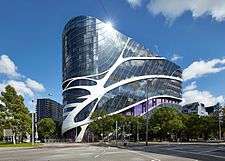
The Government of Victoria's Department of Health and Human Services oversees about 30 public hospitals in the Melbourne metropolitan region, and 13 health services organisations.[208]
There are many major medical, neuroscience and biotechnology research institutions located in Melbourne: St. Vincent's Institute of Medical Research, Australian Stem Cell Centre, the Burnet Institute, Australian Regenerative Medicine Institute, Victorian Institute of Chemical Sciences, Brain Research Institute, Peter MacCallum Cancer Centre, the Walter and Eliza Hall Institute of Medical Research, and the Melbourne Neuropsychiatry Centre.
Other institutions include the Howard Florey Institute, the Murdoch Childrens Research Institute, Baker Heart and Diabetes Institute and the Australian Synchrotron.[209] Many of these institutions are associated with and are located near universities. Melbourne also is the home of the Royal Children's Hospital and the Monash Children's Hospital.
Among Australian capital cities, Melbourne ties with Canberra in first place for the highest male life expectancy (80.0 years) and ranks second behind Perth in female life expectancy (84.1 years).[210]
Transport
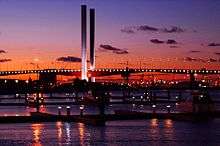
Like many Australian cities, Melbourne has a high dependency on the automobile for transport,[211] particularly in the outer suburban areas where the largest number of cars are bought,[212] with a total of 3.6 million private vehicles using 22,320 km (13,870 mi) of road, and one of the highest lengths of road per capita in the world.[211] The early 20th century saw an increase in popularity of automobiles, resulting in large-scale suburban expansion and a tendency towards the development of urban sprawl–like all Australian cities, inhabitants would live in the suburbs and commute to the city for work.[213] By the mid 1950s there was just under 200 passenger vehicles per 1000 people, and by 2013 there was 600 passenger vehicles per 1000 people.[214] Today it has an extensive network of freeways and arterial roadways used by private vehicles including freight as well as public transport systems including buses and taxis. Major highways feeding into the city include the Eastern Freeway, Monash Freeway and West Gate Freeway (which spans the large West Gate Bridge), whilst other freeways circumnavigate the city or lead to other major cities, including CityLink (which spans the large Bolte Bridge), Eastlink, the Western Ring Road, Calder Freeway, Tullamarine Freeway (main airport link) and the Hume Freeway which links Melbourne and Sydney.[215]
Melbourne has an integrated public transport system based around extensive train, tram, bus and taxi systems. Flinders Street station was the world's busiest passenger station in 1927 and Melbourne's tram network overtook Sydney's to become the world's largest in the 1940s. From the 1940s, public transport usage in Melbourne declined due to a rapid expansion of the road and freeway network, with the largest declines in tram and bus usage.[216] This decline quickened in the early 1990s due to large public transport service cuts.[216] The operations of Melbourne's public transport system was privatised in 1999 through a franchising model, with operational responsibilities for the train, tram and bus networks licensed to private companies.[217] After 1996 there was a rapid increase in public transport patronage due to growth in employment in central Melbourne, with the mode share for commuters increasing to 14.8% and 8.4% of all trips.[218][216] A target of 20% public transport mode share for Melbourne by 2020 was set by the state government in 2006.[219] Since 2006 public transport patronage has grown by over 20%.[219]
The Melbourne rail network dates back to the 1850s gold rush era, and today consists of 218 suburban stations on 16 lines which radiate from the City Loop, a mostly-underground subway system around the CBD. Flinders Street station, Australia's busiest rail hub, serves the entire network, and remains a prominent Melbourne landmark and meeting place.[220] The city has rail connections with regional Victorian cities, as well as direct interstate rail services which depart from Melbourne's other major rail terminus, Southern Cross station, in Docklands. The Overland to Adelaide departs twice a week, while the XPT to Sydney departs twice daily. In the 2017–2018 financial year, the Melbourne rail network recorded 240.9 million passenger trips, the highest ridership in its history.[221] Many rail lines, along with dedicated lines and rail yards, are also used for freight.
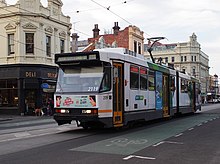
Melbourne's tram network dates from the 1880s land boom and, as of 2019, consists of 250 km (155.3 mi) of double track, 475 trams, 25 routes, and 1,763 tram stops,[222] making it the largest in the world.[23][223] In 2017–2018, 206.3 million passenger trips were made by tram.[221] Around 75 per cent of Melbourne's tram network shares road space with other vehicles, while the rest of the network is separated or are light rail routes.[222] Melbourne's trams are recognised as iconic cultural assets and a tourist attraction. Heritage trams operate on the free City Circle route, intended for visitors to Melbourne, and heritage restaurant trams travel through the city and surrounding areas during the evening.[224] Melbourne is currently building 50 new E Class trams with some already in service in 2014. The E Class trams are about 30 metres long and are superior to the C2 class tram of similar length. Melbourne's bus network consists of almost 300 routes which mainly service the outer suburbs and fill the gaps in the network between rail and tram services.[224][225] 127.6 million passenger trips were recorded on Melbourne's buses in 2013–2014, an increase of 10.2 percent on the previous year.[226]
Ship transport is an important component of Melbourne's transport system. The Port of Melbourne is Australia's largest container and general cargo port and also its busiest. The port handled two million shipping containers in a 12-month period during 2007, making it one of the top five ports in the Southern Hemisphere.[227] Station Pier on Port Phillip Bay is the main passenger ship terminal with cruise ships and the Spirit of Tasmania ferries which cross Bass Strait to Tasmania docking there.[228] Ferries and water taxis run from berths along the Yarra River as far upstream as South Yarra and across Port Phillip Bay.
Melbourne has four airports. Melbourne Airport, at Tullamarine, is the city's main international and domestic gateway and second busiest in Australia. The airport is home base for passenger airline Jetstar Airways and cargo airlines Australian air Express and Toll Priority; and is a major hub for Qantas and Virgin Australia. Avalon Airport, located between Melbourne and Geelong, is a secondary hub of Jetstar. It is also used as a freight and maintenance facility. Buses and taxis are the only forms of public transport to and from the city's main airports. Air Ambulance facilities are available for domestic and international transportation of patients.[229] Melbourne also has a significant general aviation airport, Moorabbin Airport in the city's south east that also handles a small number of passenger flights. Essendon Airport, which was once the city's main airport also handles passenger flights, general aviation and some cargo flights.[230]
The city also has a bicycle sharing system that was established in 2010[231] and uses a network of marked road lanes and segregated cycle facilities.
Utilities
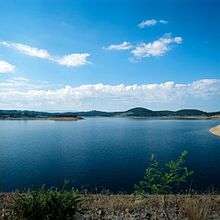
Water storage and supply for Melbourne is managed by Melbourne Water, which is owned by the Victorian Government. The organisation is also responsible for management of sewerage and the major water catchments in the region as well as the Wonthaggi desalination plant and North–South Pipeline. Water is stored in a series of reservoirs located within and outside the Greater Melbourne area. The largest dam, the Thomson River Dam, located in the Victorian Alps, is capable of holding around 60% of Melbourne's water capacity,[232] while smaller dams such as the Upper Yarra Dam, Yan Yean Reservoir, and the Cardinia Reservoir carry secondary supplies.
Gas is provided by three distribution companies:
- AusNet Services, which provides gas from Melbourne's inner western suburbs to southwestern Victoria.
- Multinet Gas, which provides gas from Melbourne's inner eastern suburbs to eastern Victoria. (owned by SP AusNet after acquisition, but continuing to trade under the brand name Multinet Gas)
- Australian Gas Networks, which provides gas from Melbourne's inner northern suburbs to northern Victoria, as well as the majority of southeastern Victoria.
Electricity is provided by five distribution companies:
- Citipower, which provides power to Melbourne's CBD, and some inner suburbs
- Powercor, which provides power to the outer western suburbs, as well as all of western Victoria (Citipower and Powercor are owned by the same entity)
- Jemena, which provides power to the northern and inner western suburbs
- United Energy, which provides power to the inner eastern and southeastern suburbs, and the Mornington Peninsula
- AusNet Services, which provides power to the outer eastern suburbs and all of the north and east of Victoria.
Numerous telecommunications companies provide Melbourne with terrestrial and mobile telecommunications services and wireless internet services and at least since 2016 Melbourne offers a free public WiFi which allows for up to 250 MB per device in some areas of the city.
Crime
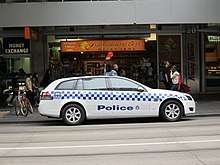
Melbourne has one of the lowest crime rates of any major city globally, ranking 5th in The Economist's 2017 Safe Cities Index.[233] Reports of crime in Victoria fell by 7.8 per cent in 2018 to its lowest in three years, with 5,922 cases per 100,000 people.[234] Melbourne's city centre (CBD) reported the highest incident rate of local government areas in Victoria.[234]
Notes
- In the US and parts of the UK, the variant pronunciation /ˈmɛlbɔːrn/ MEL-born is also accepted.[8][9]
- The use of the term Melburnian can be traced back to 1876 where the case for Melburnian over Melbournian was made in the Melbourne Grammar School publication, the Melburnian. "The diphthong, 'ou' is not a Latin diphthong: hence, we argued this way, Melburnia would be [the] Latin form of name, and from it comes Melburnian."[12][13]
- In accordance with the Australian Bureau of Statistics source, England, Scotland, Mainland China and the Special Administrative Regions of Hong Kong and Macau are listed separately
- As a percentage of 4,207,291 persons who nominated their ancestry at the 2016 census.
- The Australian Bureau of Statistics has stated that most who nominate "Australian" as their ancestry are part of the Anglo-Celtic group.[182]
- Of any ancestry. Includes those identifying as Aboriginal Australians or Torres Strait Islanders. Indigenous identification is separate to the ancestry question on the Australian Census and persons identifying as Aboriginal or Torres Strait Islander may identify any ancestry.
References
- "3218.0 – Regional Population Growth, Australia, 2018–19, ESTIMATED RESIDENT POPULATION – States and Territories - Greater Capital City Statistical Areas, 30 June 2019". Australian Bureau of Statistics. 25 March 2020. Retrieved 25 March 2020.
- https://www.censusdata.abs.gov.au/CensusOutput/copsub2016.NSF/All%20docs%20by%20catNo/2016~Community%20Profile~2GMEL/$File/GCP_2GMEL.zip?OpenElement
- "Great Circle Distance between MELBOURNE and CANBERRA". Geoscience Australia. March 2004.
- "Great Circle Distance between MELBOURNE and ADELAIDE". Geoscience Australia. March 2004.
- "Great Circle Distance between MELBOURNE and SYDNEY". Geoscience Australia. March 2004.
- "Great Circle Distance between MELBOURNE and BRISBANE". Geoscience Australia. March 2004.
- "Great Circle Distance between MELBOURNE and PERTH". Geoscience Australia. March 2004.
- Wells, John C. (2008), Longman Pronunciation Dictionary (3rd ed.), Longman, ISBN 9781405881180
- Butler, S., ed. (2013). "Melbourne". Macquarie Dictionary (6th ed.). Sydney: Macmillan Publishers Group Australia 2015. 1952 pages. ISBN 978-18-7642-966-9.
- "2016 Census of Population and Housing".
- "Victorian Local Government Directory" (PDF). Department of Planning and Community Development, Government of Victoria. p. 11. Archived from the original (PDF) on 15 September 2009. Retrieved 11 September 2009.
- Oxford English Dictionary Additions Series, iii, s.v. "Melburnian".
- Macquarie Dictionary, Fourth Edition (2005) Or less commonly Melbournites. Melbourne, The Macquarie Library Pty Ltd. ISBN 1-876429-14-3.
- "History of the City of Melbourne" (PDF). City of Melbourne. November 1997. pp. 8–10. Retrieved 28 January 2018.
- New South Wales Government Gazette, 12 April 1837 (No.271), p. 303.
- Lewis, Miles (1995). Melbourne: the city's history and development (2nd ed.). Melbourne: City of Melbourne. p. 25. ISBN 0-949624-71-3.
- Cervero, Robert B. (1998). The Transit Metropolis: A Global Inquiry. Chicago: Island Press. p. 320. ISBN 1-55963-591-6.
- Davidson, Jim (2 August 2014). "Rise and fall of British empire viewed through its cities". The Australian. Australia. Retrieved 7 September 2018.
- "Commonwealth of Australia Constitution Act" (PDF). Department of the Attorney-General, Government of Australia. p. 45 (Section 125). Archived from the original (PDF) on 11 March 2010. Retrieved 11 September 2009.
- "The Global Financial Centres Index 22" (PDF). Long Finance. September 2017.
- Stephanie Chalkley-Rhoden (16 August 2017). "World's most liveable city: Melbourne takes top spot for seventh year running". Australian Broadcasting Corporation. Retrieved 17 August 2017.
- "Government outlines vision for Port of Melbourne Freight Hub" (Press release). 2006. Archived from the original on 8 July 2012. Retrieved 26 July 2007.
- "Investing in Transport Chapter 3 – East/West, Section 3.1.2 – Tram Network" (PDF). Department of Transport, Government of Victoria. Retrieved 21 November 2009.
- Gary Presland, The First Residents of Melbourne's Western Region, (revised edition), Harriland Press, 1997. ISBN 0-646-33150-7
- Archived 8 September 2008 at the Wayback Machine
- Gary Presland, Aboriginal Melbourne: The Lost Land of the Kulin People, Harriland Press (1985), Second edition 1994, ISBN 0-9577004-2-3
- "Foundation of the Settlement". History of the City of Melbourne. City of Melbourne. 1997. Archived from the original on 20 February 2011. Retrieved 13 July 2010.
- Isabel Ellender and Peter Christiansen, People of the Merri Merri. The Wurundjeri in Colonial Days, Merri Creek Management Committee, 2001 ISBN 0-9577728-0-7
- Button, James (4 October 2003). "Secrets of a forgotten settlement". The Age. Melbourne: Fairfax Media. Retrieved 19 October 2008.
- Annear, Robyn (2005). Bearbrass: Imagining Early Melbourne. Melbourne, Victoria: Black Inc. p. 6. ISBN 1863953973.
- Chisholm, Hugh, ed. (1911). . Encyclopædia Britannica. 18 (11th ed.). Cambridge University Press. p. 91.
- "Melbourne's Godfather". The West Australian. 50 (14, 996). Western Australia. 14 July 1934. p. 6. Retrieved 20 September 2017 – via National Library of Australia.
- "Roads". City of Melbourne. Archived from the original on 20 February 2011. Retrieved 29 September 2008.
- "29 Jan 1938 - THEY CALLED MELBOURNE BAREBRASS - Trove". Trove.nla.gov.au. 29 January 1938. Retrieved 16 March 2019.
- Premier Postal History. "Post Office List". Retrieved 11 April 2008.
- James Boyce, 1835: The Founding of Melbourne and the Conquest of Australia, Black Inc, 2011, page 151 citing Richard Broome, "Victoria" in McGrath (ed.), Contested Ground: 129
- James Boyce, 1835: The Founding of Melbourne and the Conquest of Australia, Black Inc, 2011, p.186
- James Boyce, 1835: The Founding of Melbourne and the Conquest of Australia, Black Inc, 2011, p.199
- James Boyce, 1835: The Founding of Melbourne and the Conquest of Australia, Black Inc, 2011, page 163
- "Separation". EMelbourne-Encyclopedia of Melbourne. Retrieved 7 July 2015.
- Victorian Cultural Collaboration. "Gold". Special Broadcasting Service. Archived from the original on 24 July 2008. Retrieved 18 July 2008.
- "The Snowy Mountains Scheme and Multicultural Australia". ATSE. Archived from the original on 6 January 2010. Retrieved 21 June 2010.
- Hagan, Kate (3 December 2006). "Eureka: where multiculturalism was born", The Age. Retrieved 15 November 2018.
- "Media Business Communication time line since 1861". Caslon. Archived from the original on 6 December 2012. Retrieved 29 September 2008.
- Pennings, Mark (2012). Origins of Australian Football: Victoria's Early History: Volume 1: Amateur Heroes and the Rise of Clubs, 1858 to 1876. Connor Court Publishing Pty Ltd. ISBN 9781921421471, p. 11
- Goodman, Robin; Buxton, Michael; Moloney, Susie (2016). "The early development of Melbourne". Planning Melbourne: Lessons for a Sustainable City. CSIRO Publishing. ISBN 9780643104747. Retrieved 16 June 2019.
By 1890, Melbourne was the second-largest city in the British Empire and one of the world's richest.
- "The Story of Melbourne". The Argus. Melbourne: National Library of Australia. 9 September 1926. p. 8 Supplement: An Historic Souvenir. Retrieved 24 January 2012.
- Button, James (10 January 2004). "He came, he saw, he marvelled". The Age. Fairfax. Retrieved 7 July 2012.
- Cannon, Michael (1966). The Land Boomers. Melbourne University Press; Cambridge University Press.
- "Marvellous Melbourne – Introduction of the Hydraulic Lift". Museum Victoria. Retrieved 21 June 2010.
- Miles, Lewis (1995). Melbourne the city's history and development. City of Melbourne. p. 47.
- Lambert, Tim. "A Brief History of Melbourne". Local Histories. Retrieved 29 September 2008.
- "Melbourne (Victoria) – growth of the city". Encyclopedia Britannica. Retrieved 29 September 2008.
- "Fast Facts on Melbourne History". We Love Melbourne. Retrieved 29 September 2008.
- Lewis, Miles Bannatyne (1995). Melbourne: the city's history and development. p. 113–114. ISBN 0949624888.
- "1961 – the Impact of Post-War Immigration". Museum Victoria. Retrieved 21 June 2010.
- Ketchel, Misha (11 December 2012). "Boutique battle at Paris end of town". The Age. Fairfax Media.
- Wilson, Tom. "The art of the forgotten people". IPA. Archived from the original on 13 March 2016.
- Wade, Matt (2014). "Sydney takes manufacturing capital crown from Melbourne". The Sydney Morning Herald. Retrieved 20 July 2014.
- "Sorry, we can't find the content you're looking for - State Library o…". 5 August 2012. Archived from the original on 5 August 2012.
- Judith Raphael Buckrich (1996) Melbourne's Grand Boulevard: the Story of St Kilda Road. Published State Library of Victoria
- Logan, William (1985). The Gentrification of inner Melbourne: a political geography of inner city housing. Brisbane, Australia: University of Queensland Press. pp. 148–160. ISBN 0-7022-1729-8.
- Millar, Royce (7 November 2005). "Road to ... where?". Age. Fairfax. Retrieved 11 December 2012.
- Shepherd, Dick (4 February 1972). "Hotel men expected to press for Govt. aid". Age. Fairfax. Retrieved 25 April 2011.
- "Tell Melbourne it's over, we won". Sydney Morning Herald. Fairfax Media. 31 December 2003. Retrieved 18 July 2008.
- Saward, Joe (1 February 1996). "Interview – Judith Griggs". Grandprix. Inside F1. Archived from the original on 17 January 2010. Retrieved 14 May 2010.
- Miles Lewis. Melbourne the city's history and development. p. 203,205–206.
- Marino, Melissa; Colebatch, Tim (24 March 2005). "Melbourne's population booms". The Age. Melbourne. Retrieved 18 July 2008.
- "Delivering Melbourne's newest sustainable communities". Victoria Online. State of Victoria. 21 September 2006. Archived from the original on 4 June 2010. Retrieved 21 June 2010.
- The Age, 12 February 2010
- Ormonde, Tom (14 November 2009). "Housing the bubble that no one dares burst". The Age. Melbourne. Retrieved 21 June 2010.
- Dowling, Jason (16 February 2008). "Rent crisis forces urgent action". The Age. Melbourne. Retrieved 21 June 2010.
- "The World According to GaWC 2018". Globalization and World Cities Research Network. 14 November 2018. Retrieved 16 April 2020.
- Russell, Mark (2 January 2006). "Life's a beach in Melbourne". Sydney Morning Herald. Retrieved 29 September 2008.
- "Beach Report 2007–08" (PDF). EPA. Archived from the original (PDF) on 1 October 2008. Retrieved 29 September 2008.
- Tapper, Andrew; Tapper, Nigel (1996). Gray, Kathleen (ed.). The weather and climate of Australia and New Zealand (First ed.). Melbourne, Australia: Oxford University Press. p. 300. ISBN 0-19-553393-3.
- Linacre, Edward; Geerts, Bart (1997). Climates and Weather Explained. London: Routledge. p. 379. ISBN 0-415-12519-7.
- "Melbourne Regional Office". Climate statistics for Australian locations. Bureau of Meteorology. Retrieved 30 October 2016.
- "Melbourne Regional Office". Climate statistics for Australian locations. Bureau of Meteorology. Retrieved 9 November 2010.
- "Welcome to Melbourne". City of Melbourne. Archived from the original on 19 July 2008. Retrieved 18 July 2008.
- "Bureau of Meteorology – Climate Data Online". Retrieved 6 January 2015.
- "Monthly climate statistics". Bureau of Meteorology. Retrieved 30 March 2012.
- "BOM - Australian Climate Extremes". pandora.nla.gov.au. Archived from the original on 17 March 2009.
- "Melbourne Sea Temperature". World Sea Temperatures.
- "Port Melbourne Sea Temperature". World Sea Temperatures.
- "Climate statistics for MELBOURNE REGIONAL OFFICE". Climate statistics for Australian locations. Bureau of Meteorology. Retrieved 18 April 2020.
- "Highest Temperature - 086071". Bureau of Meteorology. Retrieved 26 October 2018.
- "Lowest Temperature - 086071". Bureau of Meteorology. Retrieved 26 October 2018.
- "Australian cities among the largest and least densely settled in the world". architectureau.com. 20 April 2017. Retrieved 14 April 2020.
- Freeman-Greene, Suzy (12 December 2004). "Melbourne's love affair with lanes". The Age. Melbourne. Retrieved 18 July 2008.
- Weston Bate (1994). Essential but unplanned : the story of Melbourne's lanes. City of Melbourne.
- Carey, Adam (17 June 2018). "Population pressure a fast-growing concern for Victorian voters", The Age. Retrieved 28 November 2018.
- "Australia 108". The Skyscraper Center. Council on Tall Buildings and Urban Habitat. Retrieved 19 November 2019.
- "Walking Melbourne, Heritage, Architecture, Skyscraper and Buildings Database". Walking Melbourne. Retrieved 28 September 2008.
- "Melbourne Architecture". Melbourne Travel Guide. Archived from the original on 15 September 2008. Retrieved 28 September 2008.
- "Glen Iris still the heart of city's sprawl". The Age. Melbourne. 5 August 2002. Retrieved 18 July 2008.
- "The death of the great Australian dream". The Guardian. 11 March 2016. Retrieved 16 April 2020.
- Timms, Peter (2006). Australia's quarter acre : the story of the ordinary suburban garden. Miegunyah Press. ISBN 978-0-522-85185-4.
- Lucas, Clay; Millar, Royce (11 March 2008). "Victoria: the garden state or greenhouse capital?". The Age. Melbourne. Retrieved 29 September 2008.
- "Victoria". wilmap.com.au. Retrieved 29 September 2008.
- "Victoria Australia, aka "The Garden State"". goway.com. Retrieved 29 September 2008.
- "City of Melbourne — Parks and Gardens". City of Melbourne. Archived from the original on 30 August 2004. Retrieved 28 September 2008.
- "Melbourne's Best Gardens". weekendnotes.com. Retrieved 20 February 2015.
- "About Parks Victoria". Parks Victoria. Archived from the original on 25 July 2008. Retrieved 29 September 2008.
- R Taylor (January 1999). Wild Places of Greater Melbourne. CSIRO Publishing. p. 224. ISBN 9780957747104.
- "Vicnet Directory — Local Government". Vicnet. Archived from the original on 28 September 2008. Retrieved 29 September 2008.
- "Metropolitan Melbourne – Live in Victoria". Liveinvictoria.vic.gov.au. 12 August 2009. Archived from the original on 24 January 2010. Retrieved 21 June 2010.
- Wilson, Andrew (17 April 2011). "City shortage pushes up rents". Domain. Fairfax Media. Retrieved 7 July 2012.
- "The rental pressure cooker". The Age. Australia: Fairfax Media. 3 April 2010.
- "Melbourne housing now 'severely unaffordable'". The Age. Melbourne: Fairfax Media. 24 January 2011.
- "Project Database". Urban Melbourne.
- Dovey, Kim (2013). Fluid City: Transforming Melbourne's Urban Waterfront. Routledge. p. 1. ISBN 9781135159719.
- Murray, John; Armstrong, Mark (1999). Victoria: From High Country to High Culture. p. 39. ISBN 9780864427342.
- Peregoy, Beau (20 March 2017). "7 Examples to Prove Melbourne Has Stunning Victorian Architecture". Architectural Digest. Retrieved 13 May 2020.
- "Number of 150m+ Completed Buildings - The Skyscraper Center". www.skyscrapercenter.com. Council on Tall Buildings and Urban Habitat. Retrieved 24 July 2020.
- "Walking Melbourne". Retrieved 9 January 2012.
- Chapman, Heather; Stillman, Jill (2016). Lost Melbourne. Pavilion Books. ISBN 9-78-191049674-9.
- Annear, Robyn (2014). A City Lost and Found: Whelan the Wrecker's Melbourne. Black Inc. ISBN 9-78-192223141-3.
- "What makes Melbourne the cultural capital of Australia?". Meld Magazine - Australia's international student news website. 12 July 2016. Retrieved 26 March 2018.
- Temple, Emily (10 May 2018). "The 12 Most Popular Libraries in the World", LitHub. Retrieved 28 May 2020.
- Ackland, Michael (1993). Henry Kendall: Poetry, Prose and Selected Correspondence. University of Queensland Press, ISBN 9780702223082, p. 140.
- Bellanta, Melissa (2014). "A Masculine Romance: The Sentimental Bloke and Australian Culture in the War- and Early Interwar Years". Journal of Popular Romance Studies. 4 (2).
- "Cities of Literature". cityofliterature.com. Retrieved 20 February 2015.
- Sadler, Denham (14 August 2015). "Live music in Melbourne: four of the best places to see a gig", The Guardian. Retrieved 13 November 2018.
- "Southbank Theatre". Melbourne Theatre Company. Melbourne Theatre Company. 2014. Retrieved 9 November 2014.
- Donoughue, Paul (12 April 2018). "Melbourne is the live music capital of the world, study says", ABC News. Retrieved 13 November 2018.
- Music Victoria (2017). "Melbourne Live Music Census 2017 Report" (PDF).
- National Heritage Places - Sidney Myer Music Bowl, Department of Environment and Energy. Retrieved 13 November 2018.
- Delaney, Cornelius (2020). "We're the Most Fabulous People Australia Has Ever Known". In Nichols, David; Perillo, Sophie (ed.). Urban Australia and Post-Punk: Exploring Dogs in Space. Springer Nature. pp. 73–80. ISBN 9789813297029.
- Van Maas, Sander (2015). Thresholds of Listening: Sound, Technics, Space. Fordham Univ Press, ISBN 9780823264391, pp. 223–224.
- Sayers, Andrew (2001). Australian Art. Oxford University Press. ISBN 9780192842145, pp. 79–80.
- Lock-Weir, Tracy (2009). "Misty moderns: Australian Tonalists 1915–1950", National Gallery of Australia. Retrieved 13 May 2020.
- Scopelianos, Sarah (5 April 2020). "Melbourne is famous for its laneway street art. But artists work in a 'grey area' — and worry about the future", ABC News. Retrieved 20 May 2020.
- Jopp, Ryan (8 June 2017). "Melbourne’s love-hate relationship with being Australia’s ‘street art capital’", The Conversation. Retrieved 20 May 2020.
- More Australian than Aristotelian: The Australian Bushranger Film, 1904–1914. By William Routt Archived 24 December 2010 at the Wayback Machine
- Davey, Philip (17 December 2009). "When Hollywood Came To Melbourne", acmi.net.au. Retrieved 23 May 2020.
- Grant, Barry Keith (2007). Schirmer Encyclopedia of Film, Volume 1. Schirmer Reference, ISBN 9780028657912, p. 136.
- "Docklands Studios - Bringing Screen Ideas to Life". Docklands Studios.
- Hess, Rob; Symons, Caroline; Hemphill, Dennis. "Sporting Culture". eMelbourne. Retrieved 17 November 2018.
- "Australian city of Melbourne crowned 'sports city of the decade'". China Daily. 21 April 2016. Retrieved 13 November 2018.
- "1956 Melbourne". athletesedge.info. Archived from the original on 2 November 2013. Retrieved 2 May 2013.
- Strong, Geoff (5 March 2008). "Australian sports museum opens at MCG". The Age. Melbourne: Fairfax Media. Retrieved 18 July 2008.
- Nauright, John (ed.) (2012). Sports around the World: History, Culture, and Practice, ABC-CLIO. ISBN 9781598843019, pp. 350–351.
- Wilson, John K.; Promfet, Richard (ed.) (2019). Historical Perspectives on Sports Economics: Lessons from the Field, Edward Elgar Publishing. ISBN 9781788977845, p. 25.
- Smith, Patrick (1 August 2008). "AFL blueprint for third stadium". The Australian. News Corporation. Archived from the original on 9 August 2008. Retrieved 22 October 2008.
- BRW 1000 Archived 29 August 2007 at the Wayback Machine
- "Port Botany: Australia's biggest container port". www.portauthoritynsw.com.au. Archived from the original on 28 November 2018. Retrieved 28 November 2018.
- planmelbourne.vic.gov.au Archived 9 October 2016 at the Wayback Machine
- "The Global Financial Centres Index 25" (PDF). Long Finance. March 2019. Retrieved 21 April 2019.
- "Worldwide Centers of Commerce Index" (PDF). 2008. Retrieved 10 October 2008.
- Matt Wade (8 February 2014). "Sydney takes manufacturing capital crown from Melbourne". The Sydney Morning Herald. Retrieved 30 March 2014.
- "Crown casino records profit growth, up 130%". Business Day. 26 August 2010. Archived from the original on 7 March 2012. Retrieved 10 June 2012.
- "Business Victoria – Manufacturing". State of Victoria, Australia. 26 May 2008. Archived from the original on 3 November 2013. Retrieved 22 October 2008.
- "Invest Victoria – Biotechnology and Life Sciences". Archived from the original on 5 July 2013.
- Minister for Tourism (21 July 2004). "Media Release: Melbourne Airport passenger figures strongest on record". Department of Premier and Cabinet. Archived from the original on 2 May 2008. Retrieved 18 July 2008.
- Kleinman, Rachel (1 May 2006). "Councillors furious about convention centre deal". The Age. Melbourne.
- "What are the most expensive cities to live in?". Retrieved 16 February 2014.
- "Victoria's Top 20 Attractions". Only Melbourne. 27 September 2013. Retrieved 30 March 2014.
- "These Are The World's Most Visited Cities Among International Travelers, 2019". CEO World. 5 December 2020. Retrieved 17 April 2020.
- "Australian Tourism Statistics 2019". Budget Direct. Retrieved 17 April 2020.
- "Victoria's Top 20 Attractions". Only Melbourne. 27 September 2013. Retrieved 30 March 2014.
- "Luna Park, St Kilda". Malvern Standard. 9 (507). Victoria, Australia. 21 December 1912. p. 3. Retrieved 18 May 2016 – via National Library of Australia.
- Dee, Siobhan (2012). "100 years of fun at Luna Park". National Film and Sound Arcive. Retrieved 13 May 2020.
- Kylie McLaughlin (18 August 2014). "Melbourne named the world's friendliest city, Sydney fifth". The Sydney Morning Herald. Retrieved 18 August 2014.
- "Conde Nast Traveler The 2014 Friendliest and Unfriendliest Cities in the World". Condé Nast Traveler. 5 August 2014. Retrieved 18 August 2014.
- "Safe cities index 2019" (PDF). Safe Cities Index. The Economist. Retrieved 17 April 2020.
- Khoury, Matt; Prendergarst, Luke (18 November 2018). "Melbourne fans: 50 ways our city is the best". CNN. Retrieved 17 April 2020.
- Henly, Susan Gough (28 October 2017). "Melbourne's cafe cool culture". Australian Traveller. Retrieved 12 November 2018.
- Bourget, Audrey (12 November 2018). "You haven't really experienced Melbourne until you've had pasta at Pellegrini's". SBS Australia. Retrieved 17 April 2020.
- "Sisto Malaspina: The cafe owner who has stirred Melbourne's grief". BBC. 20 November 2018. Retrieved 17 April 2020.
- https://www.abs.gov.au/ausstats/abs@.nsf/mf/3218.0
- O'Leary, John. "Resurgence of Marvellous Melbourne" (PDF). People and Place. Monash University. 7, 1: 38. Archived from the original (PDF) on 29 September 2011. Retrieved 10 November 2006.
- https://www.smh.com.au/politics/federal/population-growth-flatlining-as-visa-holders-and-tourists-disappear-20200617-p553fk.html
- "Growth pains on the city's fringe". The Age. 1 August 2012. Retrieved 24 August 2012.
- staff writers (27 April 2010). "Business – Melbourne will be Australia's biggest city by 2037". News.com.au. Retrieved 30 March 2014.
- "Population Projections, Australia, 2006 to 2101". Australian Bureau of Statistics. Retrieved 4 September 2008.
- "Melbourne to overtake Sydney by 2040". abc.net.au. 23 May 2013. Retrieved 30 March 2014.
- "Melbourne 2030 – in summary". Victorian Government, Department of Sustainability and Environment. Archived from the original on 7 September 2008. Retrieved 5 October 2008.
- "City of Melbourne: Strategic Planning — Postcode 3000". City of Melbourne. Archived from the original on 12 September 2008. Retrieved 5 October 2008.
- Smith, Rohan (5 October 2018). "There’s a reason Melbourne feels so crowded — it’s the most densely populated area in Australia", news.com.au. Retrieved 14 April 2019.
- "2016 Census Community Profiles: Greater Melbourne". Quick Stats Census Data.
- Statistics, c=AU; o=Commonwealth of Australia; ou=Australian Bureau of. "Feature Article - Ethnic and Cultural Diversity in Australia (Feature Article)". www.abs.gov.au.
- "2016 Census QuickStats". Quick Stats Census Data.
- "Victorian Architectural Period — Melbourne". Walking Melbourne. Retrieved 5 October 2008.
- "Census 2016: Why Australians are Losing their Religion". ABC Religion and Ethics. Retrieved 27 March 2018.
- "2016 Census Community Profiles - Greater Melbourne". Australian Bureau of Statistics. Retrieved 27 March 2018.
- Saeed, Abdullah. "Islam - The Encyclopedia of Melbourne Online". eMelbourne: The City Past and Present.
- Freiberg, Freda (2001). "Judith Berman, Holocaust Remembrance in Australian Jewish Communities, 1945–2000". UWA Press. Archived from the original on 1 June 2012. Retrieved 22 October 2008.
- "The Kadimah & Yiddish Melbourne in the 20th Century". Jewish Cultural Centre and National Library: "Kadima". Retrieved 9 January 2007.
- "Jewish Community of Melbourne, Australia". The Museum of the Jewish People at Beit Hatfutsot. Retrieved 5 October 2008.
- "News". The Australian Jewish News. Retrieved 28 August 2010.
- "School Ranking". www.mychoiceschools.com.au/. Retrieved 29 May 2020.
- "World's top university cities revealed". RMIT News. RMIT University. 30 May 2008. Archived from the original on 19 July 2008. Retrieved 18 July 2008.
- "WEHI: Our research partners". Walter and Eliza Hall Institute of Medical Research. University of Melbourne. Archived from the original on 27 September 2011. Retrieved 13 July 2011.
- "University of Melbourne". Times Higher Education (THE). Retrieved 20 September 2018.
- "Monash University". Times Higher Education (THE). Retrieved 20 September 2018.
- "Group of Eight Australia". go8.edu.au. Retrieved 20 February 2015.
- "RMIT University Rankings". Top Universities.
- "Excellence in Research Australia 2015: Physics research strongly recognised". Swindon University. 4 December 2015. Retrieved 12 May 2020.
- "University of Melbourne's international student offers rise as its demand leaps". University of Melbourne. 12 January 2007. Archived from the original on 30 July 2008. Retrieved 18 July 2008.
- "Department of Education and Early Childhood Development: About Us". Education Victoria. Archived from the original on 1 June 2012. Retrieved 2 May 2010.
- "Ramsay St House Sale" (25 January 2013), The Courier-Mail.
- "Victoria Members – Community Broadcasting Association of Australia". CBAA. Retrieved 28 August 2010.
- Dunstan, David (12 November 2004). "The evolution of 'Clown Hall'". The Age. Melbourne. Retrieved 8 November 2010.
- "Local Government Act 1989" (PDF). Pub Law Today. 1 July 1997. Archived from the original (PDF) on 8 November 2006.
- "City Mayors: Best cities in the world". www.citymayors.com. Retrieved 27 July 2015.
- Melbourne public hospitals and Metropolitan Health Services Victorian Department of Health
- "Victorian Government Health Information Web site". health services, Victoria. Retrieved 5 October 2008.
- Sunshine Coast and WA Country and Perth Women among Longest Life Expectancy in the World, Department of Health and Ageing. Retrieved 15 October 2010. Archived 7 January 2011 at the Wayback Machine
- Jan Scheurer, Jeff Kenworthy, and Peter Newman. "Most Liveable and Best Connected? The Economic Benefits of Investing in Public Transport in Melbourne" (PDF). Archived from the original (PDF) on 27 August 2006.CS1 maint: multiple names: authors list (link)
- "Still addicted to cars". Herald Sun. Melbourne. 10 October 2007. Retrieved 18 July 2008.
- "The cars that ate Melbourne". The Age. Melbourne. 14 February 2004. Retrieved 18 July 2008.
- "Australian Social Trends". abs.gov.au. Retrieved 29 May 2015.
- "Victoria's Road Network". VicRoads. Archived from the original on 7 September 2008. Retrieved 5 October 2008.
- Mees, Paul; Groenhart, Lucy (2 January 2014). "Travel to work in Australian cities: 1976–2011". Australian Planner. 51 (1): 66–75. doi:10.1080/07293682.2013.795179. ISSN 0729-3682.
- Mees, Paul (1 July 2005). "Privatization of Rail and Tram Services in Melbourne: What Went Wrong?". Transport Reviews. 25 (4): 433–449. doi:10.1080/0144164042000335779. ISSN 0144-1647.
- "Parliament of Australia, Rural and Regional Affairs and Transport Committee; Investment of Commonwealth and State funds in public passenger transport infrastructure". Australian Senate. Archived from the original on 6 October 2009.
- Tomazin, Farrah (14 January 2008). "Public transport makes inroads, but not beyond the fringe". The Age. Melbourne: Fairfax Media. Retrieved 8 October 2010.
- "2017-18 PTV Annual Report" (PDF). Public Transport Victoria. 2018.
- "Facts & figures - Yarra Trams". Yarra Trams. Retrieved 25 August 2019.
- "Melbourne's Tram History". railpage.org.au. Archived from the original on 9 November 2008. Retrieved 28 September 2008.
- "Metlink — Your guide to public transport in Melbourne and Victoria". Metlink-Melbourne. Retrieved 5 October 2008.
- "Melbourne Buses". getting-around-melbourne.com.au. Retrieved 5 October 2008.
- "PTV Annual Report 2013-2014" (PDF). Public Transport Victoria. 11 September 2014. Retrieved 8 November 2015.
- "Port of Melbourne Sets Shipping Record". Bernama. 13 June 2007. Archived from the original on 29 September 2007. Retrieved 18 July 2008.
- "Spirit of Tasmania — One of Australia's great journeys". TT-Line Company Pty Ltd. Retrieved 5 October 2008.
- http://www.vibha.info Air ambulance australia
- "Essendon Airport". Essendon Airport. Retrieved 5 October 2008.
- Lucas, Clay (1 June 2010). "Share scheme out of the blocks for city cyclists". The Age. Fairfax Media. Retrieved 20 May 2012.
- "Dam Water Storage Levels". Melbourne Water. Archived from the original on 18 July 2008. Retrieved 18 July 2008.
- "The Safe Cities Index 2017". Economist. Retrieved 27 March 2018.
- Kerr, Jack (20 September 2018). "'The statistics speak for themselves': Victorian police point to another drop in crime". ABC News. Retrieved 20 February 2019.
Further reading
- Bell, Agnes Paton (1965). Melbourne: John Batman's Village. Melbourne, Vic: Cassell Australia.
- Boldrewood, Rolf (1896). Old Melbourne Memories. Macmillan and Co.
- Borthwick, John Stephen; McGonigal, David (1990). Insight Guide: Melbourne. Prentice Hall Travel. ISBN 978-0-13-467713-2.
- Briggs, John Joseph (1852). The History of Melbourne, in the County of Derby: Including Biographical Notices of the Coke, Melbourne, and Hardinge Families. Bemrose & Son.
- Brown-May, Andrew; Swain, Shurlee (2005). The Encyclopedia of Melbourne. Melbourne, Vic: Cambridge University Press.
- Carroll, Brian (1972). Melbourne: An Illustrated History. Lansdowne. ISBN 978-0-7018-0195-3.
- Cecil, David (1954). Melbourne. Grosset's universal library. Bobbs-Merrill. LCCN 54009486.
- Cervero, Robert (1998). The Transit Metropolis: A Global Inquiry. Washington: Island Press. ISBN 9781559635912.
- Collins, Jock; Mondello, Letizia; Breheney, John; Childs, Tim (1990). Cosmopolitan Melbourne. Explore the world in one city. Rhodes, New South Wales: Big Box Publishing. ISBN 978-0-9579624-0-8.
- Coote, Maree (2003). The Melbourne Book: A History of Now (2009 ed.). Melbournestyle Books. ISBN 978-0-9757047-4-5.
- Jim Davidson, ed. (1986). The Sydney-Melbourne Book. North Sydney, New South Wales: Allen and Unwin. ISBN 978-0-86861-819-7.
- Lewis, Miles Bannatyne; Goad, Philip; Mayne, Alan (1994). Melbourne: The City's History and Development (2nd ed.). City of Melbourne. ISBN 978-0-949624-71-0.
- McClymont, David; Armstrong, Mark (2000). Lonely Planet Melbourne. Lonely Planet. ISBN 978-1-86450-124-7.
- Newnham, William Henry (1956). Melbourne: The Biography of a City. F. W. Cheshire. LCCN 57032585.
- O'Hanlon, Seamus; Luckins, Tanja, eds. (2005). Go! Melbourne. Melbourne in the Sixties. Beaconsfield, Victoria: Melbourne Publishing Group. ISBN 978-0-9757802-0-6.
- Priestley, Susan (1995). South Melbourne: A History. Melbourne University Press. ISBN 978-0-522-84664-5.
- Tout-Smith, Deborah, ed. (2009). Melbourne: A city of stories. Museum Victoria. ISBN 978-0-9803813-7-5.



.jpg)

